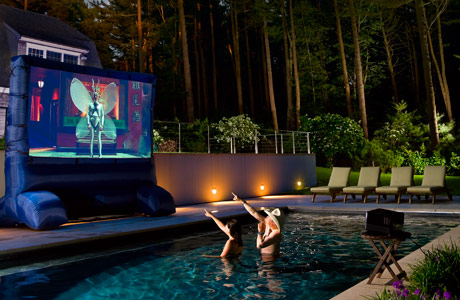Outdoor home theater: just the idea of it sounds more fun than anything you’ve ever done at the local cinema. Top-notch entertainment from the comforts of your own home: specifically, your own backyard or patio. Well, thanks to advancements in home theater technology, the dream can now be a reality.
Looking to design or install your own outdoor home theater system? We’re sure it’s going to be one of the most exciting home projects you’ve ever had. Do keep in mind that in order for your system to perform optimally – and to stay protected from unique outdoor elements like snow, rain, and too much sunlight – you’ve got to make careful considerations about how the entire system is set up. Here are a few tips to help you get started.
Get creative. Not enough budget for a high-end big-screen HDTV? Don’t worry. The centerpiece of your outdoor home theater system can be something as simple as a white bed sheet on a wall. Or it can be a piece of tarp, a painted board, or a canvas cloth. These aren’t exactly the most sophisticated options, but if you complement it with a nice, reliable projector, the results can be spectacular. Another budget-friendly alternative to HDTVs are inflatable screens designed specifically for outdoor use.
Use a projector. We’re not stopping you from buying a brand new 50-something-inch LED TV, but if you’re designing an outdoor home theater, give some thought to getting your own digital projector. These babies can deliver high-definition and high-brightness performance even in day-lit environments. (They’re not as expensive as they once were, too.) We recommend projectors with 1600 lumens brightness or higher; 720p or 1080p resolution; and with HDMI or component video connectivity.
Optimize your audio. Just because you’re outdoors doesn’t mean you can’t enjoy great audio. Home theater manufacturers now regularly come up with new outdoor speakers and UV- and weather-resistant home audio systems that sound as incredible as if you were inside a traditional cinema. Rock speakers are becoming extremely popular, too. Don’t get carried away by brand names, though: look for efficient speakers that deliver powerful bass response even in outdoor environments. (For more, check out our essential tips on buying, installing and maintaining outdoor speakers.)
Run wires through conduit. Protect your outdoor home theater installation from outdoor elements like sunlight, snow, water, and sand. Make sure you run the system’s wires through PVC conduit, and remember to seal all ends. While you’re at it, weatherproof all electrical sources, too.
If you’re using an HDTV, protect it. If you decided to buy a new plasma, LCD, or LED TV as the centerpiece of your outdoor theater, come up with ways to protect this investment. Some manufacturers produce weatherproof TV enclosures made specifically for outdoor use; you can also opt for a TV stand or mobile rack for housing the TV and other home theater components, like the DVD or Blu-Ray Disc Player and video game consoles like PS3 or Xbox 360.
Stay safe. Throughout the entire home theater installation process, remember to put safety first. Read manufacturers’ manuals (yes, it pays off to do that), use surge protectors, never touch electrical sources and components with wet hands, and always follow your building and safety codes. Another safe course of action is to call a team of home theater professionals to help you get the job done – and your dream, a reality.



I liked that you pointed out that it would be smart to use a project if you wanted your home theater to be an outdoor theater. That does seem like it would be really fun especially if you lived in a really warm area. It seems like you could probably also get a projector for inside your home as well.